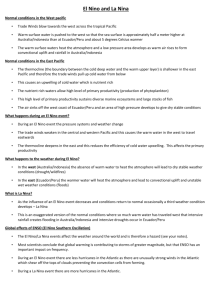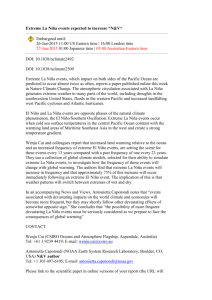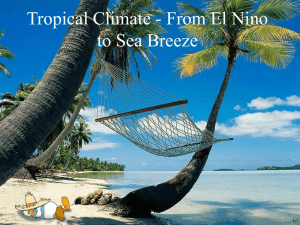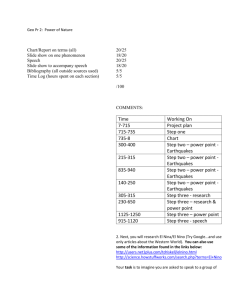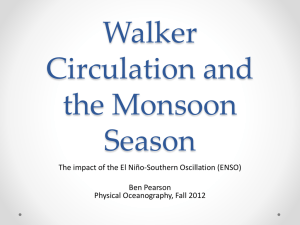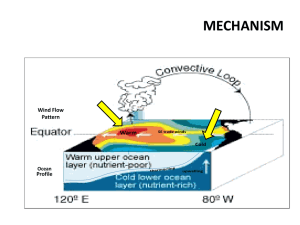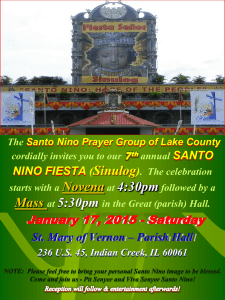El Niño and La Niño
advertisement
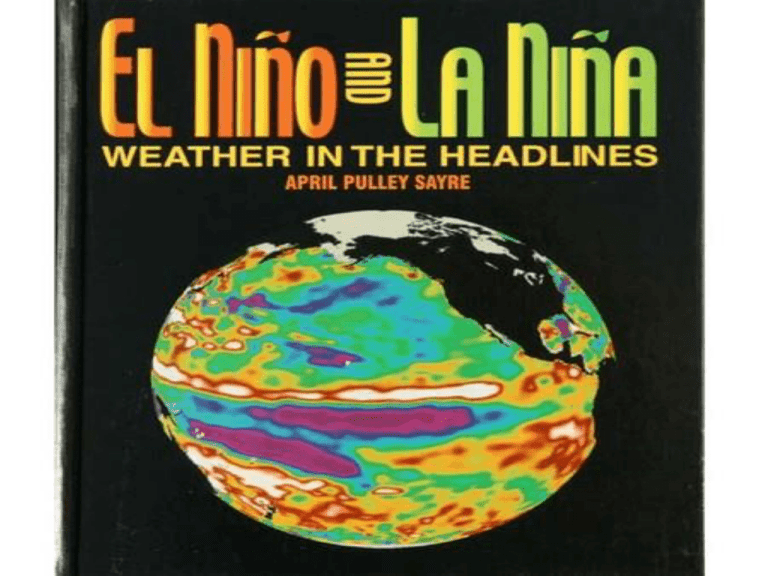
El Nino occur approximately every 3 to 5 years and can last from 6 months 2 over 2 years. An abnormal warming of surface ocean waters in the eastern tropical Pacific A quasi-periodic climate pattern that occurs across the tropical Pacific Ocean roughly every five years. average period length is 5 years La Nina’s occur in between the El Nino years and don’t last as long. It usually follows El Nino. La Nina is the opposite of El Nino and creates a cooling effect in the ocean, but does not occur as often and like its big brother La Nina changes weather patterns globally. corresponds instead to a higher sea surface temperature by a deviation of at least 0.5 °C. ENSO stands for El Nino Southern Oscillation. The Southern Oscillation is the see-saw pattern of reversing surface air pressure between the eastern and western tropical Pacific; when the surface pressure is high in the eastern tropical Pacific it is low in the western tropical Pacific, and vice-versa. The Southern Oscillation refers to variations in the temperature of the surface of the tropical eastern Pacific Ocean (warming and cooling known as El Niño and La Niña respectively) and in air surface pressure in the tropical western Pacific. The two variations are coupled: the warm oceanic phase, El Niño, accompanies high air surface pressure in the western Pacific, while the cold phase, La Niña, accompanies low air surface pressure in the western Pacific. Mechanisms that cause the oscillation remain under study. The difference between the two is that La Niña is characterized by unusually cold ocean temperatures in the equatorial Pacific while, El Niño is characterized by unusually warm ocean temperatures in the Equatorial Pacific Ocean. The El Niño always happens first and La Niña comes next. If one region or area near the Pacific experiences El Niño, another area also experiences La Niña, and vice versa. El Niño and La Niña result from interaction between the surface of the ocean and the atmosphere in the tropical Pacific. Changes in the ocean impact the atmosphere and climate patterns around the globe. In turn, changes in the atmosphere impact the ocean temperatures and currents. El Niño and La Niña Phases • El Niño Phase – Warmer than normal sea surface temperature in the Pacific Ocean near the equator • La Niña Phase – Cooler than normal sea surface temperature in the Pacific Ocean near the equator El Niño and La Niña and Rain • El Niño Phase – Increase in average rain November to March; 30% more rain than normal amount • La Niña Phase – Less than average rain November to March; 10% to 30% less than normal amount lasting from fall through winter and spring La Niña conditions: Strong cold tongue El Niño conditions: Cold tongue absent Fall 2007 CAUSES OF EL NINO The cause of El Nino is when the wind that was from east to west came from the equator in the Pacific strongly blows. This usually set up about a half of meters worth of water in the western side of Pacific. CAUSES OF LA NINA When the trade winds from east goes to west then this cause winds to increase in intensity. Normally, winds blow from the eastern Pacific to the warmer western Pacific. La Nina happens when the thermocline, trade winds and ocean temperature interacts. are warmer and drier than average in the Northwest, Northmidwest, and Northmideast United States, and therefore those regions experience reduced snowfalls. wetter winters are present in northwest Mexico and the southwest United States including central and southern California, Africa, Europe. cooler and wetter than average winters in northeast Mexico and the southeast United States. Tropical cyclones in Japan, Korea and Guam. drier conditions occur in parts of Southeast and Northern Australia , increasing bush fire. droughts in Australia, North & South America and parts of Africa warmer winters for North America, countless fishery collapses in South America change in water temperatures and the lack of flowing nutrients. great amounts of rainfall (in the northern hemisphere). massive marine life die-offs in the Pacific. Monsoons Flooding active typhoon and hurricane seasons earlier, heavier snowfall and lower temperatures in northern countries wetter-than-normal conditions in Southern Africa, drier-than-normal conditions in Northern Africa Tropical cyclones and heavy rainfalls in AsiaMalaysia, Philippines, and Indonesia Drought plagues and below-average precipitation in South America, above-average precipitation in North America Global Impacts of El Niño on weathers Global Impacts of La Nina on weathers Climate feedback (“Bjerknes feedback”) between SST and winds If trade winds weaken, then (1) Westward surface flow (SEC) weakens, allowing western Pacific warm waters to move eastward (2) cold tongue in eastern equatorial Pacific warms (3) Equatorial SST gradient is thus reduced and this further reduces the tradewinds. (4) This then becomes the El Nino condition. If trade winds strengthen, then (1) Westward surface flow (SEC) strengthens, warm pool stays in west (2) Upwelling in east provides cold surface water there (3) Equatorial SST gradient is thus increased and this further increases the tradewinds. (4) This then becomes the La Nina condition. WALKER CIRCULATION During non-El Niño conditions, the Walker circulation is seen at the surface as easterly trade winds that move water and air warmed by the sun toward the west. This also creates ocean upwelling off the coasts of Peru and Ecuador and brings nutrient-rich cold water to the surface, increasing fishing stocks. The western side of the equatorial Pacific is characterized by warm, wet low pressure weather as the collected moisture is dumped in the form of typhoons and thunderstorms. The ocean is some 60 centimetres (24 in) higher in the western Pacific as the result of this motion. GENERAL INFLUENCES OF ENSO ON PHILIPPINE CLIMATE During El Niño Episode Weak monsoon activity - delayed onset of the rainy season - early termination of the rainy season - occurrence of isolated heavy rainfall in short duration Weak tropical cyclones activity - tropical cyclones follow tracks further off the Philippines - less number of tropical cyclones entering the Philippine Area of Responsibility (PAR) During La Niña Episode Moderate to strong monsoon activity - increased cloudiness and widespread rains - near normal to early onset of the rainy season Moderate to Strong tropical cyclones activity - near normal cyclone tracks (near and/or crossing the country) - near-to-above normal cyclone occurrences in the PAR - rain-effective cyclones Below normal rainfall Above normal air temperatures Above normal rainfall Near-to-below normal air temperatures DRIER WEATHER CONDITIONS WETTER WEATHER CONDITIONS Mitigating Efforts El Nino and La Nina are the natural phenomena usually happen in the Pacific Ocean region. There are impacts and effects that somehow devastating to the human race and also to the natural resources implanted in this world. So, scientist and weather forecasters find ways in alleviating the tremendous effects of these phenomena. They exert more efforts just to discover gadgets and instruments that may help in predicting it occurrence. Furthermore, since El Nino and La Nina are natural in the environment, no one can prevent nor stop its occurrence. So, it lies on the hand of every person living on the Pacific Ocean region to educate their self regarding these phenomena, with the help of the media and weather forecasters unit. People must react responsibly whenever it will happen. Let us put in our mind that both effects of El Nino and La Nina are very important for the climate and the weather in the Philippines. Very simplified one can say: El Nino brings dry weather and even droughts while La Nina stands for rainy weather and floods. El Nino and La Nina can never be stopped yet we can do alternative ways to lessen their effects. Early crop planting Disaster management Shift in plant varieties Symposiums, Conferences and the likes Early planning There are also technologies used in determining El Nino and La Nina occurrences like: Recent technological advances have made it possible to monitor, diagnose, and predict El Niño and La Niña events in near-real time. Some of the major technologies used are: Satellite Super computers El Nino and La Nina are two natural phenomenon that are experiences not only in the Philippines but also worldwide. It is now unstoppable but there are certain ways to mitigate or lessen the impacts/effects of these problems, like : adequate assessments about and monitoring of hazards, disasters and vulnerabilities, so that the need for prevention is accurately identified and disasters defined. formulate a comprehensive plan for disaster management, disaster policy and disaster actions at the earliest possible time. develop appropriate technology and ensure the collection of relevant data on disaster through the use of satellites and the introduction of a regular system of delivering information to the public through television, radio and other mass media. self-awareness about these phenomenon, learning its causes and effects. REPORTERS : Tac-an, Maria Victoria Amarillo, Rojan Dale God Bless Us All! AMEN! To God be the Glory!

